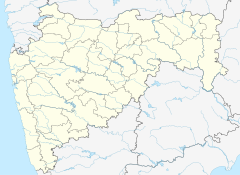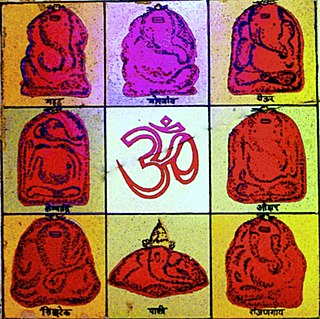
Ashtavinayaka is a Sanskrit term which means "eight Ganeshas". The Ashtavinayaka Yatra refers to a pilgrimage to the eight Hindu temples in the state of Maharashtra, India, centered around the city of Pune. The eight temples house eight distinct idols of Ganesha, the Hindu deity of unity, prosperity, learning, and removing obstacles. Each of these temples has its own individual legend and history, as distinct from each other as the murtis in each temple. The form of each murti of Ganesha and his trunk are distinct from one another. There are other temples of eight Ganesha in various other parts of Maharashtra; however, the ones around Pune are more well known and visited. To complete the Ashtavinayaka Yatra, one must revisit the first temple after visiting all the eight temples.

The Kasba Ganapati refers to both a particular murti of the god Ganapati in Pune, India, as well as to the temple built around the murti. The Kasba Ganapati is the presiding deity (gramadevata) of Pune.

Ganesh Chaturthi, also known as Vinayak Chaturthi or Ganeshotsav, is a Hindu festival that tributes Hindu deity Ganesha. The festival is marked with the installation of Ganesha's clay murtis privately in homes and publicly on elaborate pandals. Observances include chanting of Vedic hymns and Hindu texts, such as prayers and vrata (fasting). Offerings and prasada from the daily prayers, that are distributed from the pandal to the community, include sweets such as modak as it is believed to be a favourite of Lord Ganesha. The festival ends on the tenth day after start, when the Murti is carried in a public procession with music and group chanting, then immersed in a nearby body of water such as a river or sea, called visarjana on the day of Ananta Chaturdashi. In Mumbai alone, around 150,000 Murtis are immersed annually. Thereafter the clay Murti dissolves and Ganesha is believed to return to his celestial abode.
Wai is a town in Satara district of Maharashtra state in India. Located on the Krishna River, Wai was a prominent town during the Peshwa era. Two important Marathi Brahmin from ruling families had their origins here: Rani Lakshmibai of Jhansi and Gopikabai, wife of Nanasaheb Peshwa.

Varadvinayak, also spelt as Varadavinayaka, is one of the Ashtavinayak temples of the Hindu deity Ganesha. It is located in Mhad village situated in Khalapur taluka near Karjat and Khopoli of Raigad District, Maharashtra, India. The temple was built (restored) by Peshwa General Ramji Mahadev Biwalkar in 1725AD.
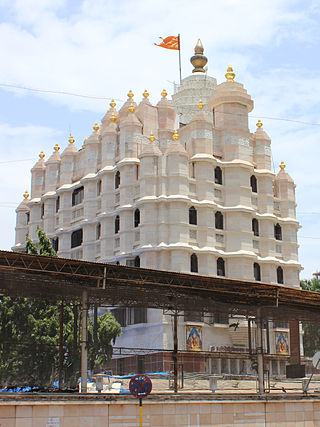
The Shri Siddhivinayak Ganapati Mandir is a Hindu temple dedicated to Ganesha. It is located in Prabhadevi neighbourhood of Mumbai, Maharashtra, India. It was originally built by Laxman Vithu and Deubai Patil on 19 November 1801. It is one of the most popular Hindu temples in Mumbai.
Budhwar Peth is one of many commercial localities in the old city of Pune, India. The area is located in the heart of the city has a high number of electronics shops, and is known for its red-light district. Three out of the five important Ganesh Mandals i.e. Jogeshwari Ganpati, Guruji Talim Mandal, Tulshibaug Ganpati are located here, as is Appa Balwant Chowk, known as ABC.
Tasgaon Tasgaon is a city in Maharashtra and Taluka in Sangli district in the Indian state of Maharashtra. Tasgaon city is developing city in Maharashtra. Tasgaon was given as Jahagir to Parshuram Bhau Tasgaonkar by Narayanrao Ballal Peshwa in 1774. Tasgaon Sansthan was lapsed by British during ruling of Shrimant Ganpatrao Tasgaonkar.
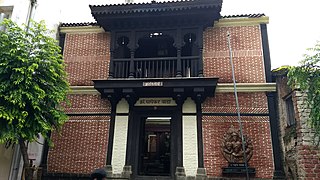
Chinchwad is an upscale locality in the city of Pimpri Chinchwad, which is about 15 km (9.3 mi) northwest of the historic city of Pune situated on the banks of Pavna river. The neighborhood is home to extensive industry and is well known for its automotive, pharmaceutical, electrical products, electronics and hardware, aerospace and manufacturing units.
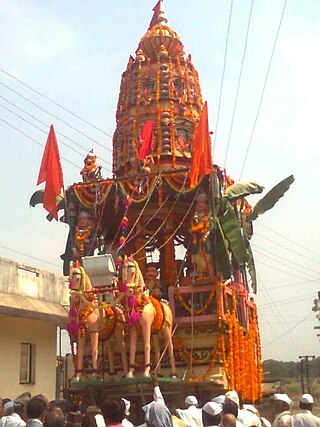
Shindkheda is a taluka in the Dhule district of Khandesh region of Maharashtra state in India. The city is situated on the west side of the Burai River.
The Dashabhuja Temple is a Hindu temple in Pune, in the Maharashtra state of India. This temple was once owned by Sardar Haripant Phadke, a Sardar of Peshwa and was later donated to the Peshwas as dowry. Dashabhuja Ganapati temple is visited by thousands of devotees every day and the number increases during Ganesh Chaturthi. The idol of Ganpati or Ganesh seen here has his elephant trunk resting on his right-hand side, which is supposed to be rarer and more sacred than other forms of the Ganesh idol.

Anjarle is a village in the Dapoli taluka of Ratnagiri district in the Maharashtra state of India. It is a small port located near the mouth of Jog river, about 4 mi (6.4 km) south of Aade and 2 mi (3.2 km) north of Suvarnadurga. The nearest railway station is Khed, 31 mi (50 km) to the southeast.
Kalewadi is a suburb of Pune in the Indian state of Maharashtra. Kalewadi mainly consists of the following areas: Nadhe Nagar, Vijay Nagar, Jyotiba Nagar, Kokane Nagar, Pavana Nagar, and Tapkir Nagar and Aliwadi, Melvinwadi and Libinnewadi.
Dhamnand is a small village within the Khed Taluka in the state of Maharashtra, India. It is situated in the Ratnagiri District beside the Vaki and Nagzari Rivers. Its population is about 4500, with the main industries being farming and forestry. The village god, or Gramdevata, is Zolai Devi.
Tulshibaug is an area in Pune City in the state of Maharashtra, India. It is located in the old city area. Its main features are a historic temple precinct and a large market.
Sadashiv Peth is an area located in Pune, in Maharashtra State of the Republic of India. It was founded by Madhavrao Peshwa in honour of Sadashivrao Peshwa.

Shrimant Bhausaheb Rangari Ganapati is a Ganesha idol in Pune. It was the first Sarvajanik Ganesha of India.

